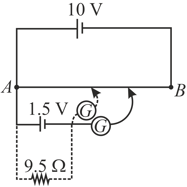Atul decides to use his bathtub water to generate electric power to run a bulb. The bathtub is located at a height of from the ground and has a capacity of . If he installs a water-driven wheel generator on the ground, at what rate in should the water drain from the bathtub to light the bulb? How long can we keep the bulb on if the bathtub was full initially? The efficiency of generator is

Important Questions on Current Electricity
A cell has an emf of and internal resistance . It is connected to an ammeter having resistance and to an external resistance of . When a voltmeter is connected across the resistance, the ammeter reading is . The resistance of the voltmeter is
A certain wire is made up into two squares with a common side of length . A current enters the rectangular network at one of the corners and leaves at the diagonally opposite corner. The current in the common side in terms of the entering current is
The e.m.f. and the internal resistance of the battery shown in figure are and respectively. The external resistance is . The resistance of the ammeter and voltmeter are and respectively. If the switch is thrown to the other side, the reading of the ammeter will be
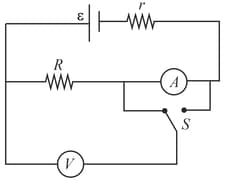
The current through the resistor shown in the figure is
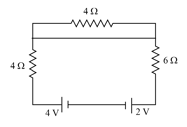
A frame is made of thin homogeneous wire (as shown in figure). Assuming that the number of successively embedded equilateral triangles (with sides decreasing by half) tends to infinity, where side is equal to and the resistance of unit length of the wire is the resistance between points and is
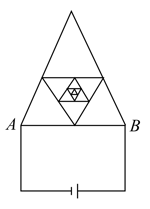
Assertion: A wire of uniform cross-section and uniform resistivity is connected across an ideal cell. Now the length of wire is doubled keeping volume of wire constant. The drift velocity of electrons after stretching the wire becomes one fourth of what it was before stretching the wire.
Reason: If a wire (of uniform resistivity and uniform cross-section) of length $l_{0}$ is stretched by a factor $n,$ then its resistance becomes $n^{2}$ times the one before stretching the wire (the volume of wire is kept constant in stretching process.) Further at constant potential difference, current is inversely proportional to resistance. Drift velocity of free electron is directly proportional to current and inversely proportional to cross-sectional area of current carrying wire.
A battery of and negligible internal resistance is connected across the diagonally opposite corners of a cubical network consisting of resistors each of resistance .
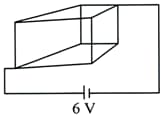
The current through the battery is
Figure shows a potentiometer used for determination of internal resistance of a cell. The balance point of the cell in the open circuit is . When a resistor of is used in the external circuit of the cell, the balance point shifts to length of the potentiometer wire. The internal resistance of the cell is
